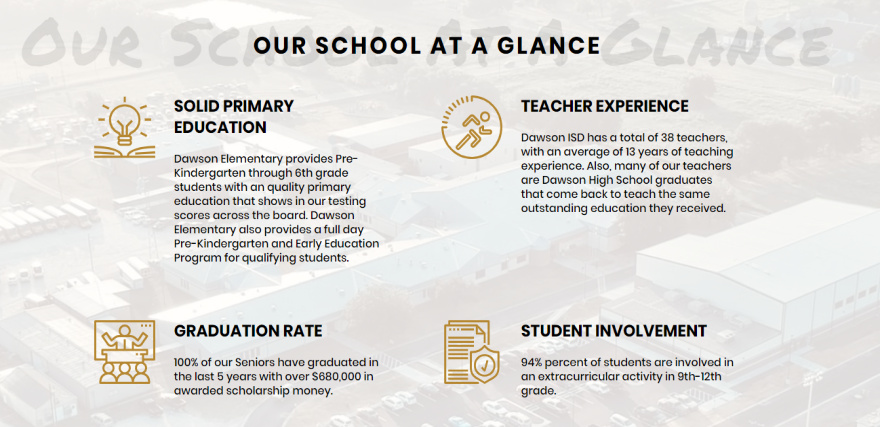Dawson ISD is a very rural 2A district in Texas. We’re located about 65 miles south of Dallas, and we serve approximately 565 students at two campuses. We serve an area of about a 20-mile radius around us, and we’re an economically disadvantaged district: The number of our children on free or reduced lunch ranges from 80% to 90%. Here’s how we keep our entire community connected, in ordinary and extraordinary times.
Starting with the Website
We ended last school year right at 500 students, and we started this school year at about 565. I attribute that big jump to the good things we’re doing in Dawson. Our teachers are killing it. We’ve got a great athletic program: we’ve gone to the playoffs in football two years in a row now. Our administrators have built us up to be one of the best schools in the area.
What has helped us showcase all of this is the website that Edlio provided for us a couple of years ago. Our site has a video header that features our kids at an assembly, having a great time. It grabs your attention, and all the kids immediately loved it because they’re in the video.
We drill into our parents to always check the district-wide calendar on the website. That’s our main place for putting out the correct time and information about events. We let parents know that they can sync the calendar with their iPhone or Google calendar so they don’t always have to go to the website if they don’t want to.
Since we closed our school building due to the COVID-19 crisis, the students are using the website more because they’re required to go to the teacher pages to get their assignments. They go to “The Dog House” heading, click on “Teacher Pages,” and they quickly find what they should be doing.
Tech Tools for Online Learning
If they have questions, students and teachers are emailing back and forth or talking over the phone if they need it. Some teachers have developed Facebook pages that they go live on, and the students can interact with the teacher that way. Others have integrated Google Classroom into their class page, so everything just seamlessly transfers back and forth. Other teachers use Zoom. They’ll go live at a certain time and invite all the kids in through their school email. The students join the room and they’ll talk about their assignment. If they need help, the teacher will help them right there in Zoom.
We made the transition from in-person to online learning in a week’s time. On a Monday, our superintendent shared a plan with the principals, who relayed it to the teachers. We all met on Thursday, and in one day they created a complete distance learning curriculum for our kids. The next Monday, we had packet pickup.
We were able to provide all of our students who didn’t have internet access at home with a hotspot that we purchased and set up within a week’s time. We also loaned them a district-owned iPad to be able to do their work from home. We’ve handed out about 100 hotspots and 220 iPads.
Feeding the Community
In a district like ours, where the average income is $33,300 a year, many kids depend on the free meals they receive at school. On the first Monday after the schools closed, we served 493 students 1,479 meals, and we continue to provide three meals per day for each day of the week. They get a hot meal when they arrive, and some frozen food their parents can cook for them later at home. We’re prepared to keep doing this as long as we need to.
We coordinate all of this through The Dog House, a new section we created on the website that I mentioned above. This is where we have our procedures, lessons for our students, vital information for their parents, our current status regarding the extended break from school, our COVID plan, our meal plan, and more.
Facebook for Parents, Instagram for Students
Social media is another big part of how we contact our parents. In a town that only has 806 people and a student population of 565, our Facebook page has 1,978 likes. Whenever we post an announcement, we share it from the website to social media. It creates a link with a little news article, like what you would see on CNN or something, that makes you click on it to get the full story. That drives traffic to our website.
Facebook is the main social media connection to our parents, but Instagram is where we get in touch with the kids. We did a survey and asked, “If you were to have a social media channel to get information from, where would you want it to be: Facebook, Instagram or Twitter?” About 75% of them said
Instagram, so that’s our social media outlet for information we need to get to students.
Translating for Spanish Speakers
Of our 565 students, about 15 come from Spanish-speaking households. Most of the children know English and Spanish, but their parents may not read English. For them, we have a “translate” feature on the website that can transform the entire page into Spanish.
Our job is to connect with students so they’ll let their parents know that the website will translate for them. For some districts, this might seem like a lot of effort for 15 students, but in a place like Dawson, we build our community one person at a time.
Cameron Shaw is the technology director, social media manager, and webmaster for Dawson ISD in Texas, where they use Edlio to build and maintain their website.
____________________________
Like this article? Sign up for ASCD Leadership SmartBrief to get news like this in your inbox, or check out all of SmartBrief’s education newsletters, covering career and technical education, educational leadership, math education and more.
